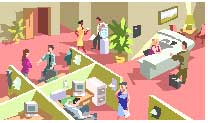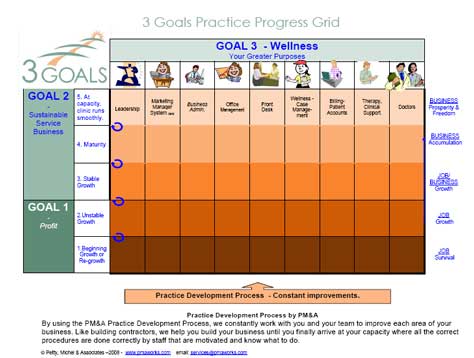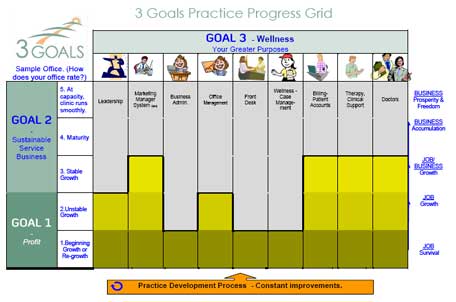
3 Goals Management System
How to Achieve Financial Abundance and Practice Freedom
A unique practice development strategy and process created by Petty, Michel & Associates
An Introduction
Goal Driven
We all have goals. When we were younger, they might have been brighter than they are now, they might have been clearer, or seemed closer. Maybe yours still are. Or, maybe, they have become dulled with wear and tear, with disappointments and frustrations.
But we are goal driven creatures and our goals stay with us. The better we can define these goals in concrete terms, the more likely we are to achieve them.
What All Doctors Want — The 3 Goals
Ultimately, all doctors would like to create a practice that allows them to provide the highest quality care to the most people for the most profit.

Most doctors want to do this with professional and personal integrity. Maybe most importantly, they want to be able to do this in such a way that they are not chained to their practice, slaving at their work at the expense of their personal and family lives.
This is a fundamental goal for all doctors, so fundamental that we call it Goal 2.
Even more fundamental, however, is basic survival and solvency. We call this Goal 1.
But nobody works just for money. Whether it’s saving the planet, helping your grand kids, assisting the poor, or funding your church, we all have higher goals.
Goal 3 are your higher purposes.
All three goals can and should be achieved, and with over 20 years of experience, we have put together a practice development system that allows doctors, and their teams, to achieve all three goals.
The 3 Goals Practice Development System is a step by step approach to help your practice grow naturally to its full potential and stay there.
Goal 1
Goal 1 is survival. In business, this means solvency. Are you making enough profit to pay your bills? To achieve Goal 1, solvency and survival, you have to move fast. It requires passion, energy, and an aggressively friendly approach to getting your services known and delivered. For the patient, you can think of Acute Care. For a staff position, you can think of 20 – 30% proficient.
Goal 2 and the Practice Development Process
Goal 2 is a fully functional, franchise-able, sale-able, and sustainable business that is very profitable. For a patient, it is a maximum spinal correction. For a staff position, it is 100% proficient and competent, rain or shine.
After you have achieved Goal 1, you can now start identifying those procedures that worked best. You can write these down on checklists. These checklists will become your Practice Playbook.
With more staff training, you can delegate more procedures to staff. As you continue to grow, you refine your procedures and continue to train your staff so that they become more competent.
Every 2 months, or as needed, you assess your list of successful procedures and add to them, or revise them. Every week you work on improving them, and train your team on them. Much like any athletic team, you practice and review your plays and procedures.
We call this process the Practice Development Process. It helps you to continually improve the practice and gradually take the office to Goal 2.
Getting Organized: The Baseball Diamond
To get to Goal 1, organization is not vital. Production, speed, and promotional activity is. However, getting to Goal 2 requires good organization.

Imagine a baseball team that stands around the pitcher’s mound with the pitcher. A batter hits a fly ball to the right field. The whole team goes to chase it. Once they reach it, they realize that no one is on the first or second base to throw the ball to in order to stop the runner. They are all out in right field.
Many offices operate this way. For example, in some offices the front desk does insurance, the insurance department does therapy, the therapist schedules appointments, and the doctor takes time off to buy office supplies.
Moving the office upward to its peak capacity includes all areas of the office improving: first base, third base, centerfield, etc. If you only have a few of the departments doing well, the other departments will hold down the entire growth.

Goal Three
Our greater goals give us meaning. These are the accomplishments we want to have said we achieved at the end of our lives. They are based in love, hope, and faith. They are for our heritage, our parents and those upon whom we owe so much; they are for our legacy, our children and their children; they are for our community and the fellowship we share with rich and poor.
Goal three is your “Give Back” goals, to your family, to your community, and to yourself.
All Three
This is your road map up and out of the roller coaster. These three goals form a sequence, but you have to keep all of them in mind as you travel up your road to success.
This is directed to a business owner, but also applies to team members and how they can improve their competency. It applies to patients, and how they travel from acute care, structural care, to wellness. It actually applies to many activities.

You have to be willing to shift between goals, and if you find yourself suddenly in the poor house, you have to lose your self-important attitude and run like a rookie again until you build your business back up to Goal 1.
Where many doctors fail is that they are not willing to shift, either up, or down, as needed. Having achieved Goal 1, they are two insecure to delegate their duties to staff and procedures, or work on improving themselves. Many doctors, having achieved Goal 1 who should be working on Goal Two, feel the need to keep doing what they did to get to Goal One and so, quickly find them selves back down struggling just to survive.
It is easy to get lost, but now, with the 3 Goals Management System, you have a road map.
We have seen too few doctors achieve financial abundance and practice freedom. Hopefully, with the tools provided in the 3 Goals Management System, more doctors will be able to reach their dreams and help others do the same.
For information on our coaching and management consulting programs. LINK
(3 goals image copyright 2009)

















